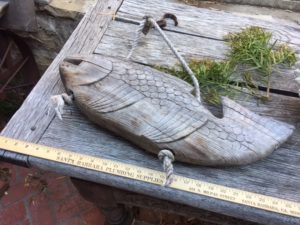 TR owns a big carved wooden fish she bought when a Long John Silver’s Restaurant closed about 25 years ago. She hung it on her garden wall for many of those years. Now that she only looks at that wall, outside her ‘office,’ her dining room table, she became curious. What the heck WAS it? This is a Japanese SARU.
TR owns a big carved wooden fish she bought when a Long John Silver’s Restaurant closed about 25 years ago. She hung it on her garden wall for many of those years. Now that she only looks at that wall, outside her ‘office,’ her dining room table, she became curious. What the heck WAS it? This is a Japanese SARU.
Here’s how it worked, and this saru DID do some work, in about 1910-1940 I estimate. In a traditional Japanese home or tea house, one sees an irori, a big indenture in the floor, a square hearth lined with stone. Over that, attached by ropes to a ceiling beam hangs a jizaikagi, an iron rod within a bamboo tube. The jizaikagi raises and lowers a suspended kettle or cookpot over the irori.
Putting Beauty to Use
They used the saru fish for a counterweight to the pot that acts as a lever. Note the three holes in the body, two at the bottom, and one at the top. The shape of the fish appears uniquely perfect for the lever action, as the nose of the fish points towards the pot and the tail serves as the actual lever. At the bottom, not the top like in the photos, the iron hook fixes on the cookpot handle. The Japanese designed everything in the main room where this hung in the early 20th century to feel unobtrusive, harmonious, and suited to its task.
Takeno Joujou (1502-1555) introduced this ancient form, often considered part of the architecture, to Japanese tea house construction. I love that the fish FORM serves the function perfectly, also that it’s in fact a CARP or Koi fish. Carp symbolize hardiness, love, and beauty, three things food and tea make us think of. And I love the subtle, out of the way USE of a simple thing made of softwood, lightly carved, and perfectly proportioned for its purpose. SO different to MY style of decorating in MY house, which my partner feels is designed to trip, bump heads, and just LOOK pretty.
This Saru’s Value
Valuable saru are the large ones, and the early ones even more so. Of course held over an open fire many disappeared over the years. The large ones speak of the size of the home and the kettle. The inhabitants of that room afforded a bigger saru, needed for the extra leverage of the pot it supported.
Searching for values for this wonderful piece, I didn’t find any offerings located in the US. If TR lost this fish, a thing of beauty, in our next fire for example, she’d need to purchase a replacement in Japan. In this country their function remains virtually unknown. This speaks to the fact that TR bought it in a closing sale of an American chain fish house, with nothing Japanese about its décor. More than likely the saru hung on a wall as a fish ornament, not as a piece of functioning architecture meant to put beauty to good use.
The name jizaikagi means, literally, free hook, meaning the hook is adjustable, raising and lowering, as well as moving the kettle to a hotter spot of fire in the irori. Such saru hung in train stations through Japan, a public buildings where they served tea, as well as in the traditional home. You find these saru mainly in softwoods, lightly varnished, but the wealthy owned such saru of bronze as well. The value is $500-800, and would bring more had TG not exposed the saru to 25 years of Santa Barbara sun.
I find it interesting that many of my readers send me photos of objects they’ve kept in their living spaces for YEARS and never wondered about the history of the object or the value. The Pandemic brought us closer to the things in our ‘architecture’ for years, and took for granted. My many emails from readers serve as an indication! Keep ‘em coming!
Fascinating fish story. You never disappoint Elizabeth
Pingback: Picasso Worthy Ceramic Fish Plate - Elizabeth Appraisals